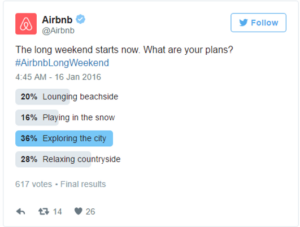The Latest in LinkedIn
LinkedIn is taking users’ ability to “connect” to the next level. This week LinkedIn is rolling out new profile features that will empower a whole new segment of users with the opportunity to become content creators and professional influencers. The professional networking platform announced the unveiling of a new “Creator Mode” to build their voice and audiences.
Social Platforms Taking a Cue from One Another
These new features are the latest of many social media shifts, as we notice a trend of social platforms taking cues from one another. Especially following almost a year of exclusively virtual networking, the media landscape is rapidly expanding to include a number of opportunities for professional and personal success. The rise of micro-influencers on Instagram, TikTok, Twitter, Clubhouse, etc. has earned the trust and loyal following of their audience members for a particular subject. There is no shortage of creative innovation on these platforms, with professionals having to develop unexpected use cases. For example, did you know personal finance TikTik was a thing? Yes, there is a growing community of young professionals offering personal finance and investment advice to followers of #FinTok or #StockTok. This just serves to show that social media platforms have much deeper opportunities for content creators than showing off their latest recipes and dance moves. With rising competition from emerging platforms, such as the audio-only app Clubhouse, or viral sensation Tik Tok connecting niche interest communities, LinkedIn is debuting similar features to remain the mainstay for professional networks. Users can now create stories (taking cues from Facebook, Instagram, and Snapchat), weigh in on trending topic hashtags (#thankyou Twitter), and now become content curators with “Creator Mode”.
Creator Mode & Influencer Opportunities
The new “Creator Mode” for LinkedIn allows users to pin specific hashtags to the top of their profile to signify the themes they frequently post about. With creator mode enabled, the presentation of profiles is altered to emphasize the hashtags directly under job titles. This moves up the “Activity and Featured” sections to highlight posts and links that a user shares before the “About” bio boxes. This shifts the content hierarchy from a self-written bio, to a curated collection of user-generated content. This allows users to focus their profiles on niche genres and topic areas to own a small space as thought leadership. In a nutshell, “Creator Mode” offers users an opportunity to connect on a more meaningful level to targeted audiences, therefore promoting themselves to influencers amongst their community.
Additionally, users can “Follow” these influencers rather than adding them to their personal networks. Now instead of feeling uneasy sending network invitations to a complete stranger, users can follow their favorite thought leaders just as easily as on other social networks.
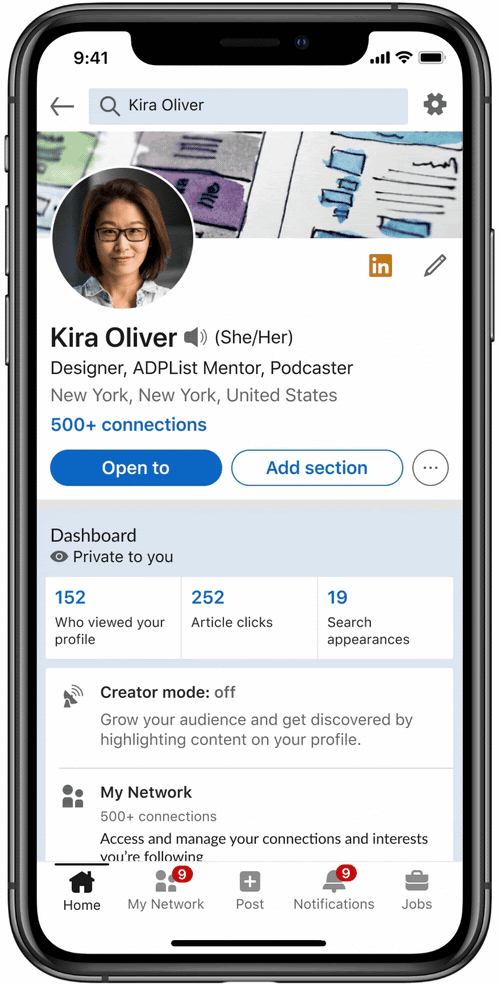
What else is included in this update? LinkedIn users can upload video cover stories, creating an interactive introduction to their profile. Much like a Facebook or Instagram story, the cover story can be initiated to play on the click of a profile photo with an orange ring. The uniquely new aspect of these cover stories is what is known as the “Harry Potter effect”, where the video will autoplay silently in the profile photo frame to signify available video content. These new features will help propel the already growing importance of video-based content on social platforms. Many users see this new video feature as an opportunity to promote themselves with a personalized pitch of their skill sets. Almost like a precursor to a job interview, it grants users the opportunity to conduct a virtual elevator pitch with all of the personality and zest of in person.
What Creator Mode Can Do For Companies
These new updates will be big for companies of almost any industry, but especially in B2B technology, cyber or complex services. Many of whom have been prioritizing thought leadership of leadership and SMEs through whitepapers, research, and media opportunities as means of generating industry attention to their brand. “As our ecosystem has been growing, and as we’re seeing the world of work changing, we’re seeing that content is now a core part of how professionals interact with not only their own jobs but their industries, their peers, and their communities,” Keren Baruch, group product manager for creator strategy at LinkedIn.
Last year 62.1 million LinkedIn users reported logging in at least once a month. This statistic is expected by researchers to jump to 64.7 million in 2021 and reach 70.9 million by 2024. The popularity of LinkedIn is expected to grow significantly, especially as users realize the unique opportunity to take control of their professional success and promote their achievements like never before. The barriers of entry for powerful brands and thought leaders have been lowered, which levels the playing field for companies of any size to become influential industry leaders.
Are you the next micro-influencer of your professional space? With the support of social media and PR agency, Bluetext, you could be! Contact us to learn more about our digital marketing and PR services.
So, you want your business to get in on the latest next-generation social platform? Stay relevant and be at the forefront of the top trending tech? Join the club. Quite literally, join Clubhouse.
In the last few weeks, Clubhouse, an audio-social app emerging from Silicon Valley has captured attention nationwide. So what is Clubhouse? Well, it’s not a dance club, and it’s not associated with Mickey Mouse, but it is the next social media sensation. It’s all the buzz of celebrities, tech investors, and digital marketers. In the first week of February alone, the app reached 2 million installs.
After many brands made the mistake of dismissing TikTok as a short-lived, tween app for dance trends, they are paying attention to the promising potential of Clubhouse. New social media apps come and go. Many fail when their UX features can’t stand up to the mainstream social giants or are acquired only to be killed (rest in peace video app Vine, which was bought by Twitter). The routine rise and fall of social media fads just prove how difficult it is to achieve adoption, capture attention, and establish habitual use of platforms.
This leads branding and digital marketing agencies, such as Bluetext, to wonder which platforms will be “the next big thing” among digital users? Where should businesses focus their attention and become social pioneers? Bluetext breaks down the rising app, Clubhouse, for its digital marketing potential.
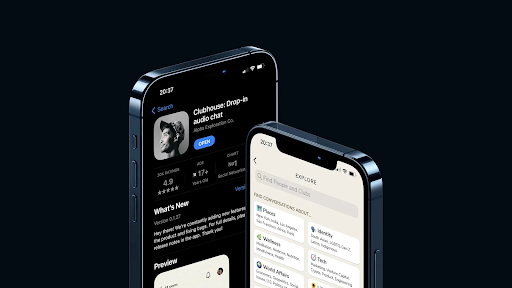
What is Clubhouse?
Clubhouse is a free, voice-based social media app with “rooms” to discuss various topics. It capitalizes on the familiarity and comfort mass audiences have found on Zoom’s “chat rooms” during the COVID-19 pandemic. Many describe Clubhouse as being on a Zoom call with the cameras off, a scenario that the remote workforce still in their pajamas at 2:00 PM knows all too well. While there is some benefit to this familiar user experience, there are also some drawbacks. Much like an overcrowded Zoom happy hour, the networking rooms can be difficult to identify the speaker and become unstructured. But maybe that’s the intent. Clubhouse has been described as a hybrid TedX talk and podcast where spontaneous conversations between strangers offer an invaluable perspective. It’s an app built for all audience types; from the passive listeners looking for entertainment, to the content creators with voices that want to be heard.
Clubhouse has taken efforts to provide a sense of order. For one, the “rooms” have a moderator with the power to mute and unmute audience members. Moderators are often thought leaders, influencers, subject matter experts, or even A-list celebrities. Users can follow their favorite moderators and have a chance to listen and participate, almost like a live two-way podcast. The app is invite-only, and the recent appearance of major celebrities and tech industry leaders has only heightened people’s curiosity and desire to adopt. Invitations are sent by current users, who receive two invites at the time of joining and the opportunity to earn more with app engagement. After news of big-name celebrities, such as Elon Musk, Oprah Winfrey, Mark Zuckerberg, guest-starring in Clubhouse rooms there has been a surge in invitations and adoptions. The app combines psychological desires of group belonging, the curiosity of mysterious and exclusive events, and fear of missing out (or “FOMO”) once you’ve achieved membership status to hook and sustain attention.
What Do Digital Marketers See in Clubhouse?
There once was a time when no one believed social media and business would overlap. But the lines of personal and professional have blurred over the years. Almost any industry can benefit from social media digital marketing, whether in paid or organic formats. Digital marketing campaigns from brand awareness to direct sales and conversions have proven successful on Facebook, Twitter, LinkedIn, and even Instagram. Any and every social media platform is subject to malleability. People will inevitably create their own use cases that meet their specific goals, which may or may not align with the original design. Platforms, like Facebook and Twitter, have evolved powerful marketing tools with robust targeting and analytical capabilities to reach worldwide audiences who have ingrained the apps into their everyday routines. We expect the same in time from Clubhouse.
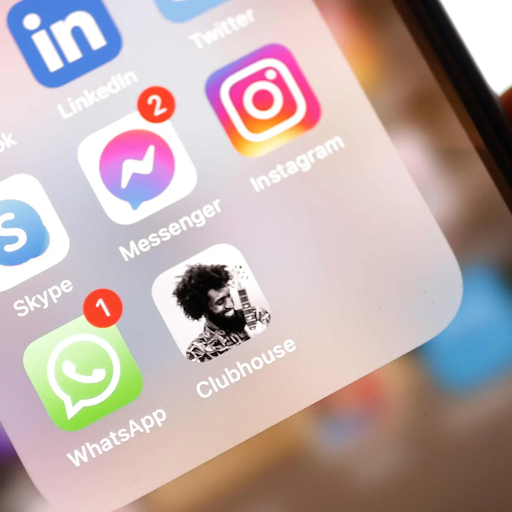
Clubhouse has a unique marketing potential because of the niche topic “rooms” and audiences. Users can select the topics of interest to them, and join “rooms” where influential moderators facilitate discussion on those topics. There is an educational element to the app, much like podcasts. This is where industry thought leaders can shine, and host “rooms” to share insights and discuss trending topics with partners, customers or competitors. Think of it as a thought leadership article turned interactive audiobook. It is a golden opportunity to spread brand awareness and strengthen reputation with an interested and interactive audience.
Digital marketers everywhere are eyeing the Clubhouse app for the potential access to exclusive audiences and marketing opportunities. Unique elements, like the invite-only exclusivity or completely live no-playback content, have users eager to join and addicted once a part of the group. In time, we expect the opportunity to share your brand story or your founding story, connect with customers, get product feedback, run focus groups, and generate awareness will only grow. And the early adopters will have a competitive edge.
Ready to be at the forefront of new technology and social trends? Get in touch with Bluetext for expert branding, digital marketing, and social media strategies.
Interactive content is here to stay. Just take a look at the 96% completion rate on BuzzFeed quizzes. Even more, a 2016 Content Marketing Institute (CMI) study found that just over 80% of marketers say that interactive content is more effective than static content when it comes to grabbing consumers’ attention.
Well, what even is interactive content, anyway? Interactive content is “content that requires the participants’ active engagement — more than simply reading or watching. In return for that engagement, participants receive real-time, hyper-relevant results they care about.”
Digital branding agencies, such as Bluetext, will ensure you are leveraging all that interactive content has to offer. Here are the top 3 types of interactive content to look out for in 2020.
Quizzes and Assessments
Quizzes and assessments are pieces of interactive content in which the user provides answers to a few questions in order to receive insights based on them. They are fun for the user to complete, and if the results are what they were looking for, they will help you build trust with your audience.
This type of interactive content doesn’t only boost engagement — they also help you get to know your audience. So when you plan to incorporate quizzes or assessments into your content plan, seek out a brand strategy agency to help you develop your content and ask yourself: What do I want to know about my audience? You may discover something new and gain some essential insights that can help you tailor your marketing efforts to be more effective.
Bluetext, a leading branding company, worked with the Graduate Management Admissions Council (GMAC) to develop a microsite to invite top-of-funnel business school candidates to learn about what is available to them in the world of graduate business schools. The introduction page on the website is an interactive quiz that helps direct users to content specifically geared toward them based on where they fall in the business school process.
Polls
Polls are the easiest and simplest way to introduce interactive content to your marketing plan. They provide a quick way to get in touch with your audience and allow you to build a genuine connection with your followers.
The most straightforward way to use polls is to ask your audience for opinions on your content, service, or product. This not only helps you drive engagement online but gives you great insight into how your audience is feeling about your brand.
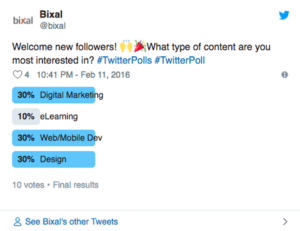
You can also invite your audience to interact with your profile by asking fun, light-hearted questions that invite them into learning more about what your company has to offer.

Contests
According to the CMI report, marketers believe that contests are the most effective type of interactive content you can use, especially in the early stage of the buyer’s journey.
Contests can include traditional raffles or giveaways. They can offer the chance to win a prize if they refer a friend to your company’s offerings. You can even introduce photos or hashtag contests where you invite your audience to submit their own user-generated content.
We have seen a rise in these types of hashtag contests and challenges across all social media platforms, especially on TikTok. The platform allows companies to leverage a hashtag to promote their brand, and users are eating it up.
Guess was the first brand in the US to release a marketing campaign as an official partner with TikTok. They ensured that every time a TikTok user opened the app, they were directed to the #InMyDenim hashtag challenge. Since its launch, videos with the hashtag have garnered over 38 million views and introduced the Guess brand to young Millenials and Generation Z.
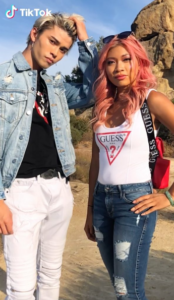
Contests are great at bringing out people’s natural curiosity and competitive spirit, so encourage them to participate by providing an engaging contest.
Interactive content that is engaging and personalized provides your audience with a new way to engage with your brand and can build trust with your audience. Learn how Bluetext can help you leverage interactive content in your content marketing plan here.
Driving engagement and other key metrics through organic social media is often an important component of a marketing campaign that targets business executives as its target audience. It complements any paid social or media, helps build awareness, and motivates target audiences to click through to a website or other campaign assets.
The question is, how do you determine the best timing in order to get the best results? This is especially tricky, given the short shelf-life of a Tweet, a Facebook post, or a LinkedIn feed. There are many myths regarding when to post organic social to drive the best results for a marketing campaign. Most of them are based on old, out-of-date assumptions, or gut instinct. Bluetext decided to test these to get hard data behind our campaigns.
The Old Common Wisdom on Social
There are some older pieces of conventional wisdom that have become ingrained in practitioners and that date back a dozen or so years to when social media campaigns were relatively new. Here are a couple that seem to make sense, but that we thought might be outdated given today’s “always-on” business culture:
- Don’t post on Mondays or Fridays. On Mondays, people are busy getting ready for the week and are likely to miss the posts. On Fridays, people are leaving early or checking out for the weekend. And never expect them to engage over their busy weekends.
- Avoid first thing in the morning and late in the day. It’s better to try other times when your target market isn’t so busy or trying to clear out of the office to get home.
Why We Wanted to Test Those Assumptions
Ultimately, we weren’t convinced that the older conventional wisdom was still valid. People work more flexible hours now than previously and are on-line and multi-tasking on a regular basis. Here at Bluetext, we wanted to get real data for ourselves so we could make the best recommendations for our clients.
How We Designed the Test
Working with a large client whose target audiences include business executives in the retail space, Bluetext designed a test that would send out social posts across three platforms where the client has a significant presence and following:
We did this over a four-week period, sending out those posts at a different time of day each week. For Facebook and LinkedIn, we also send out posts on different days of the week to see if and how that might make a difference. We looked at re-posts, replies, likes and link clicks.
The Results
Contrary to the conventional wisdom, the best results for the test’s Tweets were for those posted at 9:00 am and pm weekdays, outperforming those sent at 8:00 am, noon, or mid-afternoon.

The best results for LinkedIn were for those posted at noon on Tuesdays and Thursdays but other positive results for 9:00 am on Wednesdays and Saturdays.
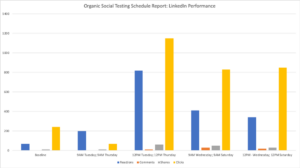
For Facebook, the best results came at noon on Tuesdays, Wednesdays, Thursdays & Saturdays.
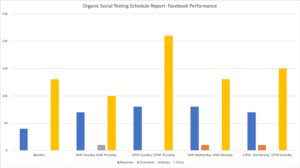
How to Leverage This New Data
Focus social posts around those best times and dates for each platform, but don’t ignore the other times or days of the week. Although posting content during “off-hours” might not deliver as much engagement, they will help to build awareness.
Establishing your brand identity online can be a daunting task, but it’s necessary to improve your brand awareness in today’s media landscape. With more than 45% of the world’s population actively using social media, it is more important now than ever to expand your brand’s reach via social media platforms. The top social media marketing and branding agencies will know just how to navigate the social sphere to bring your brand to your customers’ fingertips.
Consistent visual identity is key
Maintaining a strong corporate visual identity (CVI) across all of your social platforms is not only imperative to help your audience recognize your brand across platforms, but it also maintains the feeling of consistency, showing your customers that you’re confident with your brand. Top branding agencies can develop branded snackables for all of your social platforms, keeping the fonts, graphics and general brand identity consistent across all visuals. From Facebook and Instagram to Twitter and LinkedIn, Bluetext can provide your company with a variety of snackables for each social site, bringing your brand identity to the next level. See how Audi Field combined its digital advertising strategy with its social media strategy.
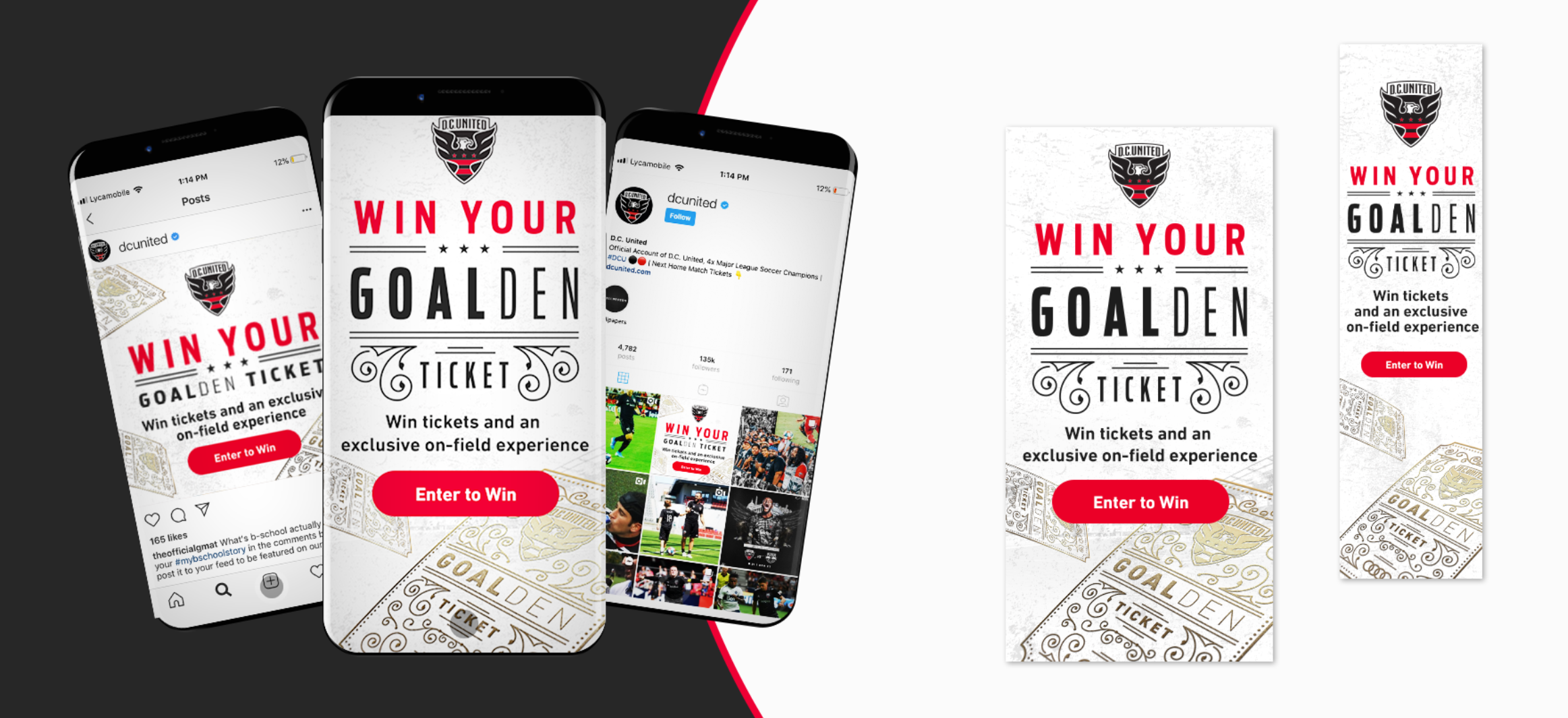
Define your brand’s voice
Okay, great – you have your company’s visual identity established…now what? Defining your brand’s voice is just as important as nailing down your CVI. Social media marketing agencies know how to position your brand to ensure that you have a unique and consistent voice across all of your social platforms, setting yourself apart from your competitors.
Although it is important to have a consistent voice, you should try to modify your tone to match the audiences across different platforms. For example, you may want to tweet something more relaxed and humorous on your company’s Twitter feed, but you would prefer to keep your LinkedIn page more professional. By tailoring your brand’s tone to match your company’s audience on each platform, you will drastically improve engagement across your social profiles.
See how Wendy’s changes their tone of voice between Twitter and LinkedIn:
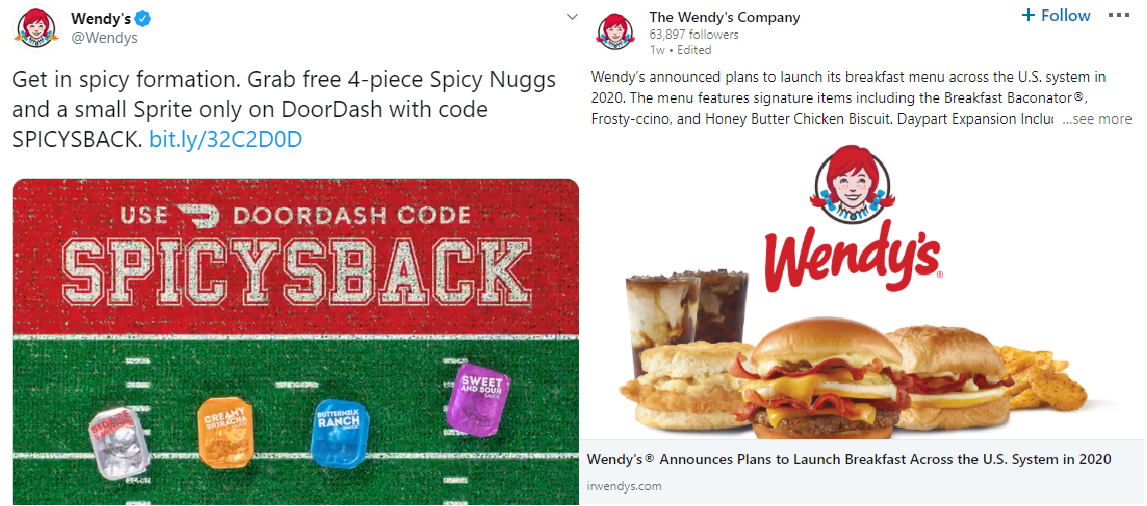
The nature of social media: content sharing
It’s no secret that social media is intended to be used to engage and share content with your peers online. This is why establishing a digital presence is a crucial step in developing your brand online. Social media users consume your posts and share them with their friends, making your brand look and feel legitimate to potential customers.
Elevate your social strategy to the next level by incorporating social media influencers to give your online presence that extra boost. Influencers will give you access to a whole new set of users outside your normal audience. With influencer marketing, you can generate brand awareness among new segments through influencers’ follower bases. The top social media marketing agencies can help you gain access to the right influencers for your audience, ensuring that your brand gets in front of large targeted audiences.
Creating your social sharing strategy
With a newly established CVI, brand voice and social media audience, you’re now equipped to draft your social calendar. It’s important to experiment with days and times when sharing content across your platforms to capture your audience when they’re actively using social media. Given the nature of each social site, your audience is likely not going to be active at the same time across all channels. This is why you should vary your post times and content. Creating unique posts per platform will keep your followers engaged from platform to platform and keep them from getting bored with your content.
Branding and social media marketing agencies like Bluetext will know how to help position your company for success online. From developing your visual identity and voice to drafting a social media content strategy, top branding agencies will give your company the exposure it needs to succeed in the social media sphere.
Ready to bring your brand and social strategy to the next level? See how Bluetext can help.
We all know the feeling: You’re scrolling through social media and you see a sponsored ad for a piece of clothing you were just looking at on your favorite retailer’s website. By now, you’re used to seeing your favorite B2C companies pop up on your social media. While it’s most common for consumer-facing companies to have a strong social media presence, B2B companies can also leverage these platforms in a similar way.
As social media has evolved, we understand much of it to be visual media, a tool that lends itself well toward B2C marketing to drive purchase conversions. While many B2C companies have already seized upon this opportunity, B2B companies can also take advantage of social media to drive insights and profits in much the same way. By turning to the right B2B marketing agency, they can help you develop an organized and creative content strategy and enhance your brand’s messaging.
The Art of LinkedIn
For B2B companies, Facebook, Twitter, and LinkedIn are the most reputable of the social media sites to establish your brand and drive awareness, with LinkedIn being the most impressive in terms of leads generated via social media.
LinkedIn is one of the most important social media channels for B2B companies to focus their attention on. This is where you can interact with industry leaders, potential employees, and future clients. While you may not necessarily be selling your capabilities through these sites, you will be able to express your brand’s legitimacy and display an understanding of your industry’s cutting-edge technologies or thought processes. A B2B marketing agency can help you develop a comprehensive social media plan to ensure that your brand’s page rollout is thoughtful and informed, which gives your company credibility and helps generate leads.
The Stats Say It All
Today, LinkedIn is by far the most efficient social media channel. 97% of B2B marketers use LinkedIn for content marketing purposes, and 80% of social leads for B2B are generated on LinkedIn.
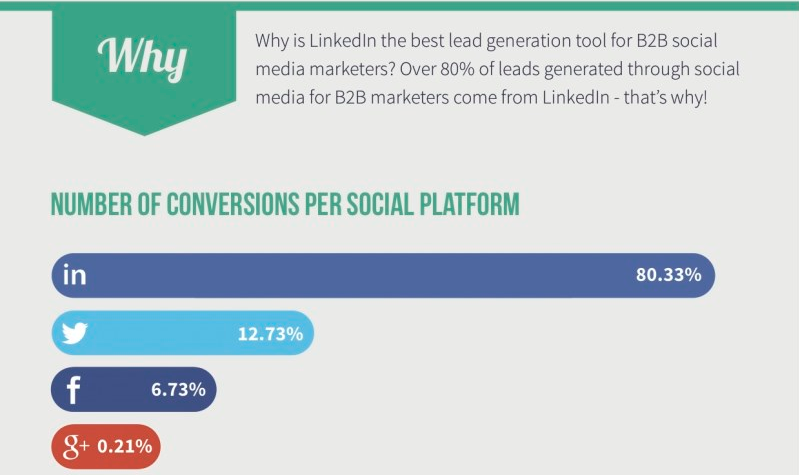 (Source)
(Source)
Additionally, 64% of corporate website visits originate on LinkedIn. That’s not a number to ignore. With the right B2B marketing agency and LinkedIn content strategy, you can be generating leads at exponentially higher rates than before you turned to LinkedIn. A B2B marketing agency, like Bluetext, will be sure to engage your audience, resulting in more site visits and leads.
____
Using social sites such as LinkedIn positions you as a forward-thinker in today’s digital world, illustrating to future clients and employees that your company is modern and innovative. Social media can be your company’s next best marketing tool that drives leads and expands your profit margins. Working with a B2B marketing agency to elevate your brand to its greatest potential ensures that you are taking advantage of all that social media has to offer.
Bluetext is a B2B marketing agency that works to advance our clients’ brands in the digital sphere, resulting in maximum lead generation and profits.
See how Bluetext has served its clients in the social media realm.
Our apologies to Samuel Taylor Coleridge, but in today’s social media landscape, it often feels like, “Content, content everywhere and not an engagement to be found!” That certainly seems true on a wide range of social media platforms, including LinkedIn, Twitter, Facebook, and Instagram.
We’ve all been there, posting on social media for our clients’ B2B brands and expecting the improbable – an engagement from a high-quality, ready-to-buy lead. Yet, as traffic on the major platforms continues to evolve, it seems like those quality leads have become more scarce. Digital Media Buying is proliferating as competition for customers heats up. But this growing competition to winning the audience’s attention is making the engagement challenge more difficult.
But thankfully, LinkedIn has figured out how to get that elusive engagement with the right targets, by literally making the improbable possible. Even better, it does so in a rather natural, organic manner.
That finally gives marketers, especially those of us who work primarily in the B2B space, something to smile about. Recent modifications to the algorithm that governs LinkedIn’s feed are boosting impressions and engagement for users with smaller audiences and connection bases while minimizing the extensive outreach of LinkedIn’s “power users.” (We see you Gary V and Richard Branson).
The market is sensing this new opportunity. There is an endless supply of professional content on LinkedIn, generating over nine billion Impressions each week. Most of this content, of course, isn’t useful, and users will soon catch on. But the demand from the public is there — waiting for the right company, thought-leader or piece of content to come along. I believe B2B Marketers have a rare opportunity to really grow with LinkedIn, and should strongly consider doubling down on their efforts.
Understanding LinkedIn’s Algorithm. If we want to build engagement, then we need to know a little about the algorithm responsible for serving content. The lofty goal of the algorithm created by LinkedIn’s engineering team is to ultimately deliver more value for the company by keeping users on the platform as long as possible. The strategy for doing that is simple: Make users feel like their time on LinkedIn is well-spent by serving up a feed of relevant, personalized content to every single one of its 610 million users.
LinkedIn’s home feed is the starting point of every user’s journey. To keep users engaged, the feed must understand the quality of every piece of content, and understand which content is relevant to whom. Failure to do so will destroy the quality of a user’s experience and turn “time well spent” into “time wasted.”
To understand how to do this, let’s first take a look at some of LinkedIn’s tactics.
LinkedIn Activity Graph. One of the core elements of the LinkedIn algorithm is the Activity Graph – a system designed to understand deep relationships between members’ content.
What’s A LinkedIn Activity? LinkedIn considers an activity to be any piece of user-generated content capable of having a subset of connected activities, which can include “likes,” comments, and shares – the common responses that demonstrate an interest in the content. And in turn, these actions become content as well.
Content Priorities. LinkedIn has a number of content types that it evaluates in order to rate them in terms of feed priority. Handpicked articles and paid ad campaigns have a much higher probability of showing up than user-generated content. Within user-generated content, LinkedIn has shifted towards a stronger balance between the various types, but with a slight priority given to video and text-only posts.
Some other types of content include:
- User-generated content by the people and pages you follow, relevant LinkedIn #hashtags and predicted interests, such as
Pulse Articles and Posts (Text, Photos, Videos, Documents, Links) - User Activities & Events (Liking, commenting, sharing, connecting, new job)
- Promoted/Sponsored Content, both internal (LinkedIn Learning Courses, LinkedIn Premium) and external (Paid ad campaigns)
- Curated Content
- Dynamic Content
How it works. The ability to keep a user’s feed relevant is critical to LinkedIn’s success and requires the ability to programmatically identify the quality and relevance of the content. Here are the steps that LinkedIn’s algorithm takes to make these determinations.
Step 1: Quality Filter Scoring: Immediately after a user posts a piece of content to their page, and before it ends up in anyone’s feed, LinkedIn’s algorithm reviews the content and marks it as Spam, Low Quality or Clear. Only the Clear survive.
For everyone’s sanity, I’ll refrain from diving into what makes a post spammy. But I do think it’s important to focus on what is deemed low-quality, which according to LinkedIn are posts that are flagged for one or more of the following:
- Having fewer than 500 words
- Having software generated responses
- Having highly promotional content.
Once that post is marked as “Clear,” it gets allocated into other users feed based on the initial priority of the content. Here’s where the real fun begins. LinkedIn begins immediately monitoring the engagement that each post generates. These include, for example:
- The number of likes, comments, and shares for the post
- The types and quality of comments
- The time spent writing the summary and post
- The engagement rate compared to the baseline rate of the person who is posting
- The action that the reader takes when they see the post. For example, do users click the post and spend time reading the article or do they immediately go somewhere else.
Step 2: Engagement Test: As noted above, the post is now being analyzed for the amount of engagement it gets within the first hour. The more likes, shares, and comments the post receives, the greater the chance of moving on to the next step.
Step 3: Relevancy Assessment. During the third step, LinkedIn will assess the profile of the person posting the content to determine the relevancy of the post to their network. The lower the relevancy, the higher the probability the post will fizzle out.
Step 4: Taking it Up a Notch. LinkedIn has decided that machines can’t have all the fun and has introduced a human element into the mix. If your post is fortunate to reach this phase, it will be passed onto a human for review to determine if it’s worth pushing to the masses.
In my next post, I’ll take this a step further and outline strategies you can begin to incorporate into your ongoing LinkedIn B2B marketing strategy. If you have questions, topics you want to be explored, or any feedback please let me know!
Want to learn more about how to design and execute a successful LinkedIn strategy?
Given the sheer amount of content playing across social media feeds in today’s online landscape, producing eye-catching, dynamic content is a must.
In order to stand out from the crowd, businesses across many different industries are increasingly turning towards creative motion to catch the attention of potential customers on social networks like Facebook and Twitter.
Why animated business video?
While there’s nothing wrong with relying on static images on your business’s social media, there’s a limit to the story you can tell, and what your potential customers can take away from a single picture or photo.
Images can only provide a limited amount of information, and are confined by their own borders to a relatively small amount of creative content. What audiences immediately see in an image is all they’re going to get.
By integrating creative motion video into your social media strategy, you gain an important tool for not only conveying more information to your potential customers, but also providing them with more eye-popping, creative content that tells a story.
While you could go with live action video, this choice, like sticking with photos and images comes with a lot of productive and creative limitations.
Animation, on the other hand, has near-infinite creative possibilities to tell your story, none of which are limited by the need to use live actors or film production equipment.
As a result, animated video is more likely to catch the attention of internet users, 50% of whom look for videos related to a product or service before visiting a store (Insivia).
Paya
We helped Paya revamp their social media pages on Facebook, Twitter, and Instagram with brand new creative motion animations like the these two:
Provide a truly modern #payment experience, wherever you do business. Choose Paya to integrate #omnichannel payment solutions, together with #ERP system insights to harness the maximum consumer potential your brand can offer. pic.twitter.com/fZt4RSHInV
— Paya (@payaHQ) May 25, 2018
Balancing concision and content delivery was critical for making sure these posts kept the attention of users while maintaining their creative charm.
Though each animation is only about 10 seconds long, the descriptions link to a longer article promoted by the video.
These posts are meant to draw in potential clients with concise, creative flair and deliver them straight to Paya’s website, where they can find more helpful articles, and a wealth of information on all the services Paya provides.
Here are three strategies for ensuring your use of animated video on social media is as effective as Paya’s.
- Take advantage of creative motion
To catch the attention of scrolling social media users, it’s critical to stand out. One way to do that is by creating highly dynamic content that creates a contrast with the still images around it. Creative motion describes content that doesn’t just use video but is full of movement set in a creative environment or background. Creative motion videos are striking and fun to watch meaning users are more likely to stop and take a look at your content.
- Use colors that pop
Along with making sure you content is full of movement, you want it to pop against the dreary grey and whites of platforms like Facebook and Twitter.
Paya uses bright colors like green, orange, and blue that catch people’s eyes and keep them watching. Experiment with different color schemes and choices to find a combination that is vibrant and pleasant to look at. Catching users’ eyes with lots of movement and bright colors is especially key for video content on social media where you’re competing with so much other content for consumers’ attention.
- Concision is a must
A recent study found that the average attention span is now around 8 seconds. That you means you have very little time to get and hold your audience’s attention. We recommend following Paya’s lead and limiting your social media video and animation content on social media to around 10 seconds to ensure potential customers don’t scroll on before you’ve gotten your message across. While a video on another platform, like on your own website, can of course be longer than 10 seconds, your social media strategy should focus on drawing users in with very short investments of their time and then exposing them to more involved content once they have left social media.
Using creative motion video on your businesses’ social media pages is an excellent way to draw in consumers with rich, but easily digestible content.
Balancing concision and compelling, creative content can be a challenge, but doing so successfully can be highly rewarding in terms of site visits and lead conversion.
| Learn how Bluetext can get results for your digital marketing campaigns. |
Top digital marketing agencies are quickly learning that mobile retargeting is now a key element in any successful campaign. But moving our clients to this strategy is not always an easy sell, as the many challenges that mobile presents can be intimidating. In spite of the roadblocks, mobile retargeting can increase reach and engagement far beyond other channels. Here are Bluetext’s six top tips for getting started with a mobile strategy:
- Unsure on how to reach target audiences on their mobile devices? Think social media platforms. Today’s target audiences are more likely to browse their social media apps on their mobile than search websites. Take advantage of the tools that Facebook, LinkedIn and Twitter offer for their ad campaigns.
- Want to increase mobile traffic to your site? Optimize your website for mobile to fully take advantage of this platform. That means a design that is responsive for all devices, and features simple and concise headlines, titles and other text. More importantly, make sure that images are sufficiently compressed, reduce the number of redirects (nobody wants to wait for a new screen to load), and minimize code to maintain a high-performing experience.
- Not sure how to design for mobile? Think like a visitor to your brand would, accessing your site via a mobile device. That means simplified designs and copy, but also calls-to-action that are clear about where the visitor will land if they click on that button. Viewers don’t want to leave the screen they are on unless they know there they are going.
- Need to improve your reach on mobile? Safari is the leading browser for mobile devices, but leveraging Apple’s tool is not so easy. One simple trick: Make sure you are enabling Safari, which typically blocks third-party cookies in its default setting. Find a provider that is skilled at accessing Safari’s massive number of users.
- Still not seeing the conversions you expect? It could be your landing page. Try to simplify the actions on the landing page to make sure there is no confusion or abandonment from that conversion point.
- Want to get hyper-specific with your targeting? Try geo-fencing for conferences, events, shows and other gatherings of target audiences. Sophisticated new geo-locating tools allow geo-fencing to specific blocks around convention centers, hotels and other venues. Serving ads at the right time and place can pay big rewards.
Any marketing campaign can be much more effective with a mobile component, as long as it’s well-executed.
If you want to learn more or need help with your campaigns, Bluetext can help.
It’s almost January again, already! With 2017 almost behind us, amidst the holiday cheer and eggnog, it’s also time to reflect on 2017. It goes without saying that today, changes in digital marketing happen within the blink of an eye. There’s simply no better strategy for your business than a continual adaptation; the years of resting your laurels with time-tested methods are long gone. What works best with digital simply changes too fast, and nothing is really stable.
With that in mind, we know how busy you are this time of year, so we’ve gotten together and brainstormed what we believed to be a list of the most important digital marketing trends for 2018. It’s a big list, but we’ve narrowed it down to just a top four. We invite you to take a look — if only to just keep up with the ever changing modern media environment.
